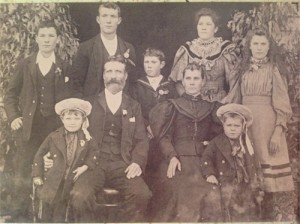
The family of William Daniel Patrick O’Brien about 1897. Tom O’Brien went to war and returned to captain the first Tumut Maher Cup team. Here he is with his dad’s arm around him. Younger brother Assal and Orlando (top left) both died in the War. [Source: Ancestry.com]
Below are the team lists with brief biographical information. Further down is the analysis which you can jump to here.
The Tumut and Gundagai team selections were published before the match in the Tumut & Adelong Times, the Adelong & Tumut Express and the Gundagai Times. However none of the post match reports list the players that took to the field that day. Gundagai scorer Bert Davis was not in the lists of the selected, while chosen Jim Slater fractured his kneecap in a game three days before the Cup match and never played again. So the list includes reserves and Davis.
THE TUMUT TEAM
Ernie ‘Curly’ Dunn (1896-1926)
From Adelong. A locally regarded artist he died in the Adelong footballer’s motor accident of May 1926. His gravestone reads ‘accidentally killed in the football disaster on the Tumbarumba road 16 May 1926 aged 29. Also killed was 18 year old Eddie Crompton. Ernie Dunn was a single man with a dependent mother. Following his death a benefit match was staged for her.
Jim ‘Buck’ Elphick, (1898-1965)
James William Elphick was a winger for Tumut. While a labourer he came from a prominent pioneering family, an uncle, James Elphick, was a councillor for more than 30 years and frequently the mayor of Tumut. Another uncle, Harry was a prominent Australian Workers’ Union organiser. ‘Buck’s brother Harry died in the Great War, while another brother, Jack, who played in the forwards for Tumut, later became deputy mayor of Botany. Never marrying he lived most of his life in Tumut but went to Sydney in the 1950s where he worked as a storeman in Pyrmont.
Tom O’Brien (1889-1963), Captain
Thompson Joseph O’Brien was born in Adelong, but lived, except for schooling and war service, at ‘Rosebank’ on the Gilmore Creek for forty years from 1899. He was the son of W.D.P. O’Brien, once owner of the rich Gibraltar mine near Grahamstown, committed Labourite, ‘Fenian‘, councillor and benefactor, the builder of O’Brien’s Hall, the butter and bacon curing factory, freezing works, the Nun’s Chapel at the Tumut Catholic church, the driver of municipal tree planting etc. Tom O’Brien went to private school in Melbourne where he emerged as a natural leader and excelled in football, cricket and rowing. He returned to run the family property ‘Rosebank’ with brother Assal, but soon went to the Great War (his record is wrongly stamped ‘deceased’). He was manning a machine gun alongside Assal in the Middle East when Assal was killed. His other brother Orlando died on the Western Front. After the war Tom managed the Commercial Hotel in Tumut, developed a jersey stud at ‘Rosebank’, trained and owned race horses and was active in all sorts of community activities, being a councillor, authority on Maher Cup history, and later patron of Group 9 and Tumut Rugby League. From 1939 till his death he ran the Hotel Tumut.
Les Malone (1897-1968)
Leslie George Malone, one of 11 children of Tim and Bridget Malone, was from a pioneering family who settled on the Tumut Plains in 1852. Les married Bertha Piper from Gilmore, and became a policeman – later a detective. They lived in Randwick.
Walter Malone (1895-1977).
Walter Patrick Malone, the older brother of Les, broke a leg as a boy – getting it caught in the spokes of a dray, but it didn’t stop him enlisting in 1916. He was promoted to Lieutenant and wounded. After the war he was a member of an AIF Rugby team which toured Europe, and like Les, married a Tumut lass, Nellie Eurell, and became a city police detective.
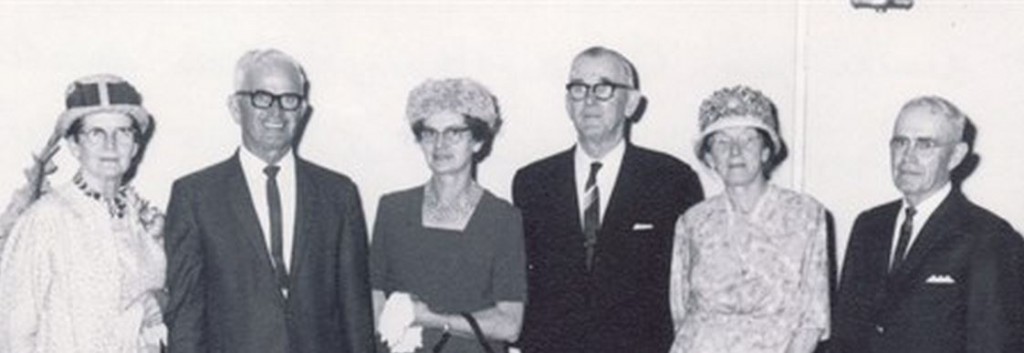
Six of the eleven children of Tim & Bridget Malone: Nell, Les, Lucy, Walter, Mary and Gus. [Source: Ancestry.com]
From a prominent Tumut Plains grazing family, his full name being, like his father, Hamlyn Lavicourt Vernon Harris. Educated at King’s College Goulburn, he briefly became a bank clerk before serving with the 1st Light Horse from November 1914. His three elder brothers were ‘original Anzacs’. In Egypt and the Sinai Vern developed malaria which would trouble him later. He settled on the Wermatong family property to become a leading Tumut citizen, involved in cricket, the agricultural society, the graziers’ association, the RSL, the Anglican Church and the Country Party. He died unexpectedly aged 58 from a heart attack and received a huge funeral.
Norman ‘Bob’ Wilkinson (1896-1985)
Usually referred to as ‘R. Wilkinson’ in team lists, he hailed from Gilmore. In the Great War he served as a driver, later a machine gunner. Bob was employed as a driver for the boss of the Gilmore to Batlow rail construction project in the early 1920s. The son of Henry William Wilkinson, he later lived in Summer Hill, Sydney with parents and brother Milton.
Con Crain (1898-1978)
William Consort Crain was a half back for Adelong and from a grazing family that had first come to Adelong Creek back in 1865. He married in 1923 and lived on the extensive Mt. Adrah property all his life. Con was also a talented cricketer and tennis player.
Jack Crompton (1895-1966)
John Edward Crompton played for Adelong. He enlisted in the 1st Light Horse in August 1914 and served at Gallipoli and in Palestine. After farming at Sandy Gully near Grahamstown he moved to Ariah Park and then to Leeton in 1945, where he became a rice inspector.
Jack Roche (1894-1974)
John Edmond was the second son of the Roche grazing family. Jack’s grandfather had originally come to the area to run a hotel at Adelong Crossing (Tumblong) in the 1850s – later having hotels at Adelong. Living all his adult life on the family farm, the appropriately named ‘Rochedale, he was also a very keen cricketer. Like brother Frank, Jack didn’t marry until in his forties.
Frank Roche (1893-1959)
Laurence Francis was the eldest of the famous grazing family from Adelong – Jack and Frank being two of six sons of John Roche senior, all of who had properties in the Adelong area. Frank served in the 7th Light Horse in Egypt and France and established a stock and station/auctioneering business in 1922 with brother Michael. Later he bought a farm at Adelong, ‘Cooleen’ and married when in forties. He was the consummate leading citizen – a shire councillor from 1939-1953, president of the Adelong RSL, secretary of the Adelong Jockey Club, and enormously active in the Catholic community.
Roy Tonkin (1900-1993)
Clement Roy Tonkin was an orchardist at Sunnyside, Wondalga (also referred to as Middle Adelong). He lost a brother, William Henry in the Great War and married Ellen Arragon, a relative of the Roches, in 1925. Ellen died in childbirth in 1936. He lived in various locales including Camden, Bourke, Coffs Harbour and the Gold Coast, where he lived to be 93.
Gerry Quirk (1896-1957)
The Quirk family came from Victoria in 1906 and established a dairy family at Bombowlee. Gerald (often the names ‘Jerome’ and ‘Jerry’ are used to identify him) later represented Group 9 against New Zealand. The family were keen and knowledgeable horsemen, his brother Ted was a well-known Tumut bookmaker. Gerry’s son Peter Quirk was a very talented Maher Cup player who became ordained as a priest.
Rube Masters (1887-1967),
Rupert Clarence Masters was born at Tumut and lived there all his life where he developed the building company his father started. In the 1930s he also owned a farm at Elong Elong near Wellington. We fell 16 feet and suffered serious injuries in 1938 at Adaminaby.
Edwin William ‘Dick’ Bridle (1896-?)
The third son of Edwin George Bridle of Bombowlee. The Bridles had first come to the Tumut area in 1848. Dick fought in the Middle East in the 2nd Light Horse Machine Gun Squadron. He married Lillian Alma Fuller (1901- 1980) at Tumut in 1924. They moved to Junee where he worked for the railways. He resided in Junee after retirement.
Reserves:
Matt Downing (1903-1969)
Matthew Sylvester Downing was the grandson of Robert Downing who married on the Murrumbidgee banks in 1843. Matt, like his father of the same name, was a butcher in Tumut. He was later president of the Tumut Turf Club. Older brother Allan J. Downing also played Maher Cup, and suffered all his life from war injuries, but was a very successful auctioneer and stock and station agent.
B. Crowe
No information found
Alf Spicer (1897-1984)
From Tichborne near Parkes Alfred George Spicer was a school teacher at Adelong from 1920 to 1924. A fine singer, he performed with the dramatic and musical societies, was secretary of the local cricket and football clubs, played tennis and loved fishing. Alf and his wife holidayed back to the area for many years.
Clarrie Joyce (1895-1940)
Robert William Clarence Joyce, a carpenter from Tumut, was rare in that he participated in four different Maher Cup teams: Tumut (1920), Gundagai (1921-22), West Wyalong (1923-25), and Cootamundra (1926-27). A Great War veteran he suffered from trachoma at that time and was repatriated to Australia only to re-enlist and return to France for a second go. He was died quite young when living at Cootamundra.
Paddy McKey (ca.1888-1974
James Patrick McKey, originally from Blowering, married in 1920 and took up a dairy farm at Gilmore. In 1934 he left the district buying a farm at Murrumba near Esk in Queensland, where he remained.
Harry Tonkin (1897-1981)
Like younger brother Roy Tonkin he was an orchardist, initially at Sunnyside, Wondalga and later having his own sheep, fruit and vegetable farm nearby. He played Maher Cup for both Tumut and Wagga, and was president of the Adelong Show Society. He won many many prizes for his produce.
Ken ‘Scotty’ McLennan (1886-1967)
Along with Rube Masters, Ken played Rugby for Tumut well before the War and featured in running races. His father was Scottish born and they lived at Bombowlee. In 1920 he was slightly injured when Cup donor E. J. Maher crashed his motor car into Scotty’s sulky when returning from the football. He was a fireman, secretary of the Rugby League club and treasurer for the Oddfellows Lodge. He left Tumut in 1924 with his wife for Gladesville in Sydney where he became a tailor. There he was prominent in the Tumut Ex-Residents Association with other footballers such as Ted Maher, Jack Elphick and Jim Treweek.
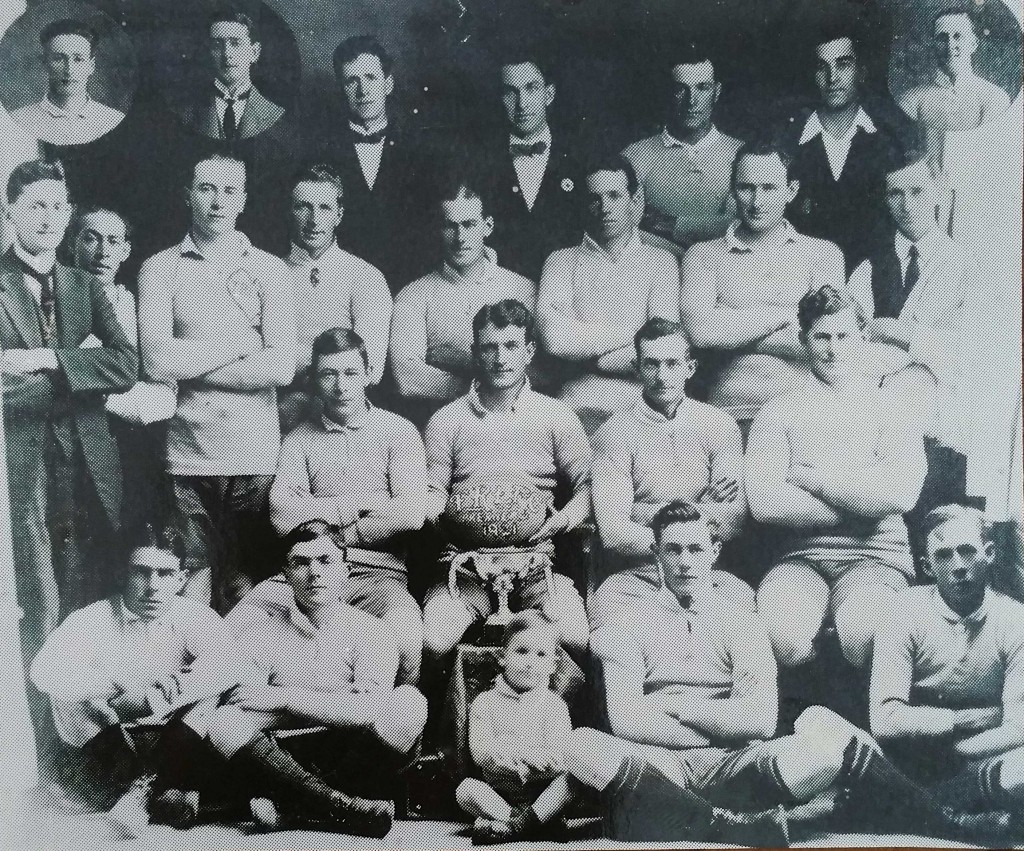
Tumut footballers 1921. Only a few of the ‘originals’ are still playing but this shot doesn’t include any Adelong players. From back left – Inserts: Hector McDonald, Frank Adams, Bill Cheffins. Back row: Ted Reid, Frank Cripps, Les Purcell, Arthur Elphick. 3rd Row: Cecil Adams (secretary), Rube McGowan, Matt Downing, Alan Downing, Tom Cooper, Rube Masters, Ted Maher, Tom Eurell. Seated: Ken McLennan, Tom O’Brien (captain), Edgar Baker, Jim Cooper. Cross-legged: Jim Elphick, Milton ‘King’ Allatt, Ralph Cripps (ballboy), Jack Elphick, Jack McNamara.
GUNDAGAI TEAM
Albert ‘Pip” Field (1900-1955)
Albert Henry Field was a fullback, winger and half-back as well as a prominent boxer and bandleader. He moved to Temora in 1922 to work in John Meagher’s grocery department, married there in 1924 and became the leader of a very popular dance band. He was the brother of fellow Gundagai footballer/boxer Wilf ‘Woody’ Field.
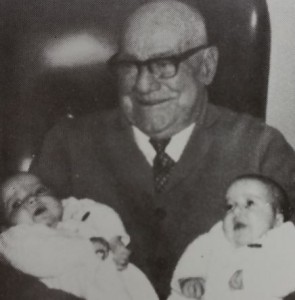
Bert Graham with his twin grand-daughters. [Source: The Church of the Immaculate Conception Tumut Centenary 1978]
Herbert Stanley Graham, the older brother of Fred Graham (see below) was a grazier at ‘Riverview’ in the Adjungbilly area before moving to Sydney in 1926. He was also a prominent local cricketer. Another brother, Jim Graham (1885-1960), was a key benefactor to the Cootamundra Rugby League, and instrumental in bringing coach Phil Regan to that town.
Tom Hunt (1890-1934)
Thomas Alfred Hunt’s widowed mother was the hostess of Gundagai’s Railway Hotel, which closed in 1925. In the Great War Tom’s role was both as a sapper and runner, he was wounded and was the last local lad to be demobbed, arriving back in Gundagai in January 1920. He received a farm on the Tarrabandra Soldiers’ Settlement, lost 24 cattle and 8 horses in the 1922 flood, and became an expert in the training of sheep dogs.
Jim Elworthy (1894-1965).
James Baker Elworthy was the grandson of the J.B. Elsworth the founder of the Gundagai Times in 1868, and before that papers at Adelong and Tumut. Jim’s father Arthur Elworthy was also the paper’s proprietor but Jim and his younger brother Jack preferred farming. Jim joined the Light Horse in 1916 with footballing mates Tom Hunt and Jim Slater as part of ‘Carmichael’s Thousand’. They fought even before leaving for the front in the Light Horse riot at Liverpool and spent three years in the Middle East, staying on in Egypt through 1919. In 1920 he took up land on the Tarrabandra Estate with Jack and although he suffered from war injuries he managed to expand it over time. Never marrying he was deeply involved in community activities, particularly around horse-racing and the RSL.
Phil Freestone (1901-1970)
Philip Henry Freestone is considered as one of the more talented Maher Cup players, although he didn’t make the national side like his younger brother Viv – ‘Bluey’ Freestone (1904-1957). Phil left town for Cootamundra and was a key figure in Phil Regan’s dominant team in 1923. He didn’t return to the Gundagai team until 1926. After retiring he refereed. Employed as a porter at the Gundagai Railway Station, Phil was transferred to Narrandera in 1935 and then to Sydney in about 1945, living at Umina in his later years.
Bill Brownrigg (1891-1964 ), probably the Captain
William Henry Machattie Brownrigg was born in the Kempsey district and graduated from Hawkesbury Agricultural College. He farmed at Molong before purchasing a property near South Gundagai. After finishing playing in 1924 he became a referee and selector. In 1928 he was appointed as an Agricultural Inspector for the Upper Eyre Peninsula District and moved to Streaky Bay, South Australia. He lived in South Australia for the rest of his life.
Viv Joyce (1891-1940)
Varney Vivian Joyce was the brother of Clarrie Joyce who also played in the first Maher Cup match – for Tumut. The Joyce brothers with their father were carpenters and builders. Viv also played cricket as well as performing in the “Black Cats” a group of minstrels. Although unmarried he was known also as ‘Dad Joyce’. In the 1930s he moved back to Tumut where the family came from, while his building work made him “well known” in Cootamundra and Canowindra.
George Wheatley (1894-1941)
George William Wheatley was a share farmer and drover. A single man he lived with his cousin James Pollack. He was called ‘Offside Wheatley’ by players for his skill in moving up quickly. He imparted his football knowledge to youngsters and in 1927 he coached the South Gundagai women’s football team for a novelty event. George lived at Gundagai all his life and followed horse racing closely until his death on 14 November 1941 following bouts of rheumatic fever.
Fred Dominick (1894-1981)
From a Coolac farming family, with a grandfather born in Croatia, Frederick Thomas Vincent Dominick served with the 55th Battalion during the First World War. He worked on the family’s Mt Pleasant property, but in the 1930s was frequently hospitalised for an “old war complaint“. His brother Sid married Margaret, the daughter of Maher Cup donor Ted Maher. Fred later moved to Sydney and the Central Coast.
Bill Whiticker (1902-1976)
William Henry Whiticker (1902-1976) was the son of William Whiticker of Jellingroe Station west of Tumblong. He married Philomina McCormick of Tumut in 1926 and lived at ‘Monabri’, Tarcutta, then moved to Tumut where he had a dairy, and briefly the Wynyard Hotel. In the 1940s he took over the Exchange Hotel at Harden where he was a prominent official with the Rugby League club. Later in the decade he settled in the Penrith area. He was the grand-father of Rugby League writer Alan Whiticker.
Ern Neiberding (1894-1967)
George Ernest Neiberding (seems to be pronounced Neberdine) was from Tumblong, his grandfather came to Sydney from Germany in 1853. He married Victoria Crain, the sister of Con Crain of Mt Adrah and the Tumut Maher Cup team. She had twelve children. Ern was a rural labourer at Tumblong and developed a small farm later at Mt Adrah .
Herb Robertson (ca.1883-1971)
The oldest player in the first Maher Cup match Herbert William Robinson was from Braidwood, moving to the Tumblong area about 1911 to work with a gold dredging company. He enlisted in 1915, was with the field ambulance at Gallipoli and later served at The Somme. He was granted a soldiers’ settlement block at Tarrabandra, married in 1927 and settled into the Gundagai community for life. He was a Past Worshipful Master of the Masonic Lodge.
Jack Smith (1890-1967).
John Smith, always known as Jack, spent most of his working life on Back Creek Station at Kimovale where he took a job for the Pastures Protection Board as rabbit inspector. He married Kitty Delaney from Kimo way in 1915. Jack was a brilliant athlete even before the War excelling at cricket, tennis and football. He played Rugby with the ‘Our Boys’ team. In 1924 he won the ballot for a 2900 acre block of rough country at Burra (near Muttama) but had to give it up. In 1931 he clean-bowled Don Bradman in his prime in a match at Cootamundra. Kitty had seven children and Jack coached three of them – sons Cecil, Jim and Jack – to be champion cricketers.
Jim Slater (1897-1992)
Cootamundra-born James Patrick Slater spent almost two years on the Western Front fighting in the two Battles of Bullecourt in which more than 10,000 Australians were killed or wounded. While selected for the first Cup match he never played – as he fractured a knee in the Tumblong-South Gundagai v Gundagai match on the Sunday before, thus ending his playing days. A benefit game was held. He set up business with George Bowditch in the Coronation Butchery in Sheridan Street, and married Helle Holborn from Coolac. When he died aged 95 he was Gundagai’s ‘last digger’.
Al Smith
Possibly Albert Edward Smith (1890-1965), WW1 digger and farmer of Tumblong.
Played but not selected:
Bert Davis (1894 -1925)
Albert Victor Davis was a very talented footballer and sprinter who moved to West Wyalong to take up a job in 1924. Charlie Davis, his Maher Cup playing brother, had moved to the mallee town earlier. There Bert was struck with ‘acute kidney trouble’ and died aged 30. He was buried at South Gundagai.
Selected as reserves:
Fred Graham (1893-1950)
Fred J Graham was a prominent grazier who owned Bongongo Station considered “one of the foremost sheep and cattle men in the State”. Sydney Royal Agricultural Show judge, a member of many farming and grazing organisations and a Shire councillor. Also an excellent cricketer and later patron of the Gundagai Rugby League.
Bill Dutton (1902-1986)
This player is probably William Allan Dillon from an Adelong family, he starting teaching at the Tumblong school and had a career teaching in various parts of the State, before settling down in Sydney.
George ‘ Dom’ Dominick (1885-1961).
As a lad George Michael Dominick was a key witness in the Mooney Mooney Station poisoning case. In 1906 he married into the Sheehan family of Adjungbilly. He fell ill in in 1922 and a benefit football match and dance where held. He worked for Gundagai Council on roads in the Gobarralong area for 37 years from 1914 to 1951. In 1927 he was granted a small block of land near Coolac and after leaving Council was listed as a grazier of Sandy Falls. Dom was a champion wicket-keeper, a staunch unionist and an ALP stalwart. He died a few days after his wife, from injuries sustained in a road accident. He was a brother of Fred Dominick.
Jack Elworthy (1898-1942)
John Douglas Elworthy, educated at Kings Schools, Parramatta, was a bank clerk when he joined up with the Light Horse in 1917. After the War he wanted a ‘freer life’ than banking and took up a 600 acre Tarrabandra Soldier Settlement block and enjoyed breeding trotters and being involved as an official and exhibitor in the Gundagai Show. He died suddenly aged 43 after an appendix operation, leaving a widow and four young daughters.
Most Players Lived Outside The Towns
Only 10 of 40 players actually lived in the towns of Gundagai and Tumut. The location of the other 30 included: Tallabandra and farms nearby at South Gundagai (6), Adelong (4), Tumut Plains (3), Bombowlee (3), Tumblong (3), Gilmore (2), Wondalga (2), Coolac (2), Mt. Adrah, Sandy Gully, Adjungbilly, Gobarralong, and Back Creek.
This reflects that most people lived on farms and in and around villages. At the 1921 census 1,638 people were living in the Tumut municipality, with another 6,191 in the surrounding Gadara Shire. At Gundagai there were 1,150 people, with 3,669 in the surrounding Shire of Adjungbilly.
Outside both the Tumut and Gundagai town limits adult men outnumbered women 6 to 4. Most males worked on farms or in forests. Mining was petering out, although there were still 240 men employed underground at Gibraltar Hill, Grahamstown in 1916. Dam construction was building up. 23 of the 40 original players can be identified as farmers or graziers.
Most Players Where Catholics
While the religion of some players is not apparent, for a majority – 22 of the 40 players – there were Catholic rituals at either their marriage or funeral. The 1921 census reports that 32% of males identified as Catholics across the four local government areas.
The War Had Robbed Teams of Some of Their Brightest
Thirteen of the 40 players had enlisted in the war. Many of these men had been wounded and suffered the rest their (often shortened) lives. Many fine local footballers and athletes died in the war including Bob Sullivan, Bill Maile, Harry Marshall and Bob Isaac of Gundagai, Frank Elphick, Assal O’Brien, Orlando O’Brien and Alan Scott of Tumut, Bert ‘Woof’ Crain, Harry Whiting, Robert Wise, Will Tonkin and Jack Melrose of Adelong and Jack Treweek at Grahamstown. Others who came home wounded physically and/or psychologically would have been athletes if not for the War.
Everyone Felt the Legacy of the War
There was a sense of collective mourning- everyone had friends and/or family who had been killed. The maimed were obvious in the street. The traumatised were less visible, often with grieving or frightened wives and family. But war always creates hope for a brighter future – and a determination to get it.
In January 1920 the Tumut & Adelong published this poem:
After the storm of grief and pain,
Striving of nations, turmoil, rush,
Upon the earth descends again
A calm, a blessed hush.After the clouds that veiled the sky,
After the blackness of the night,
Whispering that Hope can never die,
Day comes to bring up lightAfter the hours that seemed so long,
Anxieties and terrors cease,
For as we sing the victory song,
Our hearts and filled with peace
In April at a Welcome Home in the Tumut Oddfellows Hall the Mayor Gordon “…announced that at a public meeting held the previous night, it was decided to present Sgt Gus Keown who had the misfortune to lose both legs… with a house as a free gift from the people of the district…” In the fields of France he had received “gunshot wounds to his penis, feet, abdomen and hands”.
For the Perfect brothers from Adelong the damage was psychological. All four had gone to the front. In February 1920 the last, Bob returned home and they needed to celebrate. It being after hours publican James Ward of the Post Office Hotel refused their entry. Ward had previously been fined for serving one of the brothers. They kicked and punched Ward and a Mr. Cross. When the policeman came they set upon him causing life threatening injuries. The Perfects did time in Goulburn.Men Of Marginal Means Were Under-represented
In 1920 the Maher Cup was played under Rugby Union rules – changing to League in 1921. While most of us have a sense of class and code, in Tumut and Gundagai, the players just moved over to League en masse. Union wasn’t thought about again until they formed a new club in Tumut in 1983.
Our list of 40 men doesn’t include any rabbiters and shearers and only one drover. Most of the players had the security of a farm or a secure trade. The family names of many players are those of early settlers – Elphick, Malone, Harris, Crain, Wilkinson, Crompton, Roche, Tonkin, Downing, Field, Graham, Elworthy, Dominick, Whiticker and Neiberding. Many of these families had become interconnected through marriage.
One suspects two things. Firstly, teams were formed out of the community, and those well connected with the community were most likely to be welcomed into the club. Secondly, football was a dangerous pastime for a man without savings and friends to fall back on. Most work was physical and men risked their livelihood each time they risked injury. It was not until the Depression that any form of insurance was considered.
When Men Married They Usually Stopped Playing Football
There are exceptions, but in general when the footballers got married, and many did marry in their early twenties when they were in their physical prime, they gave up playing. Many continued with cricket. The risk of injury plus the responsibility of supporting the almost inevitable large family ceased the playing of boy’s games.
Travel Was Difficult and Dangerous
The deaths of Ernie Dunn and Eddie Crompton in the Adelong footballer’s accident was just an extreme example of the hazards of motorised vehicles on muddy winter roads. In 1921 there were 28,665 registered cars in NSW. The newspapers throughout the decade were dominated by automobile advertisements – the result being some 170,039 cars owned by 1929. But the roads were in poor condition, even for a horse and sulky or dray. In a 1921 Maher Cup game the Gundagai team had trouble fording the swollen Gilmore Creek and the game ended as darkness fell. In 1923 the Gundagai Independent could even have a ‘Car Mishaps’ column with the headline Motors Go Mad. Things didn’t improve – car accidents often fueled by alcohol remained a constant threat (and source of worry for mothers and wives) throughout Maher Cup history.
Drought, Rabbits & Electricity
However there were other things front centre in the minds of Murrumbidgee folk in 1920. At the start of 1920 rabbits were everywhere. The following is from the Gundagai Independent of 22 April: “…during the last four months over 5,000,000 (five million) rabbits were trapped & poisoned in the Gundagai district. The three freezing works alone have paid for over three million rabbit carcasses in that time, and taking a line by the skins purchased by local buyers, at least another two millions were poisoned, and their skins sold. The money this brought to workers runs to about £72,00. In other words about 1,000 persons have, for the past four months, earned on an average £5 per week in Gundagai district rabbit trapping”. This was more than the average wage.
However by April the rabbits were becoming scarce as a severe drought took hold. The sheep population had fallen sharply. Fortunately it started to break as seasonal thoughts returned to football. But probably the biggest topic of conversation was the coming of electricity to Tumut and Gundagai – still some time off but eagerly awaited.
REFERENCES
- Butcher, Cliff. Gundagai: a track winding back. 2002
- Census of the Commonwealth of Australia 1921: part X, New South Wales
- The Church of the Immaculate Conception Tumut Centenary 1878-1978
- Grant, Jan & Penny, June. Monumental Inscriptions and Burials: Gundagai Cemeteries 1846-2010. 2011.
- Gundagai Independent
- Hassett, Annette. Along the Creek: Shepardstown, Grahanstown, Mount Horeb. 1999
- Hassett, Annette. Along the Creek Revisited: Shepardstown, Grahanstown, Mount Horeb. 2008
- Hedley, Kevin. Tumut Shire 1887-1987. 1987
- Luders, Peter E. Gundagai and the Land of the Two Rivers. 2010
- Madigan, John. The Maher Cup and Tumut. 1995
- Memories of Tumut Plains / compiled by residents and ex-residents. 1993
- Murray, Rachel. Gundagai Goes to War. 2010
- The Official Year Book of New South Wales 1929-30
- Quince, Lyn. Voices from the Valley: a collection of reminiscences of Tumut’s senior citizens. 1991
- Tumut and Adelong Times
- Tumut and District Sesqui Centenary 1824-1974
- Tumut Centenary Celebrations 1824-1924 : Official Souvenir
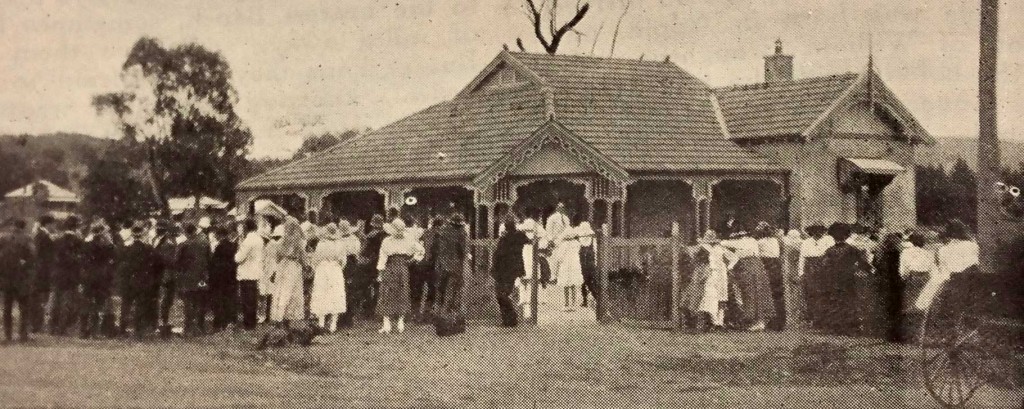

Love this game
Did the Wiles Boys from Adelong Play ?
….and any early team Photos ? 🙂
I can’t find a record of any Wiles playing Maher Cup and the Tumut team lists are almost totally complete. Was Vincent Wiles one of the ‘Wiles Boys’? What decade did they play?